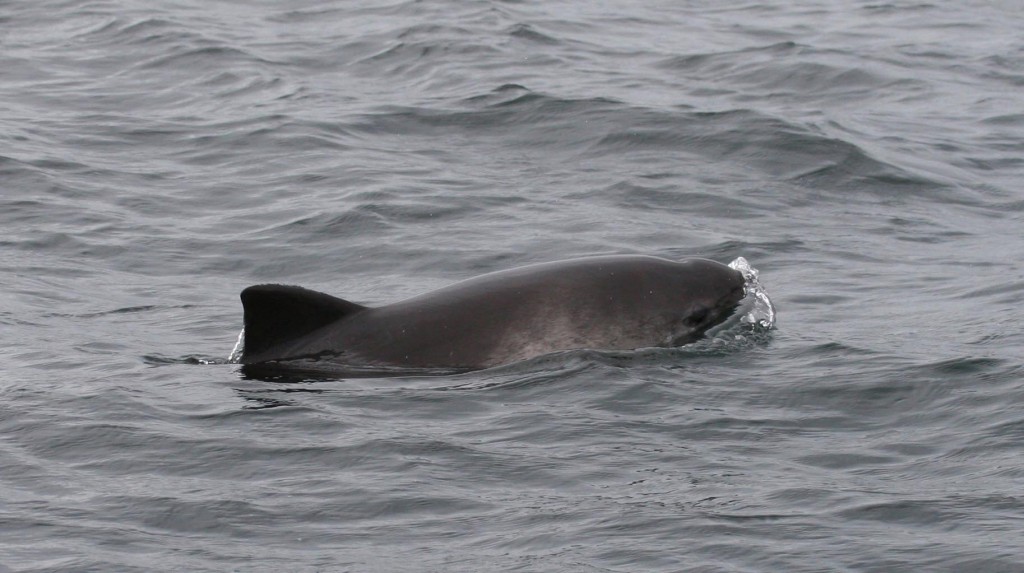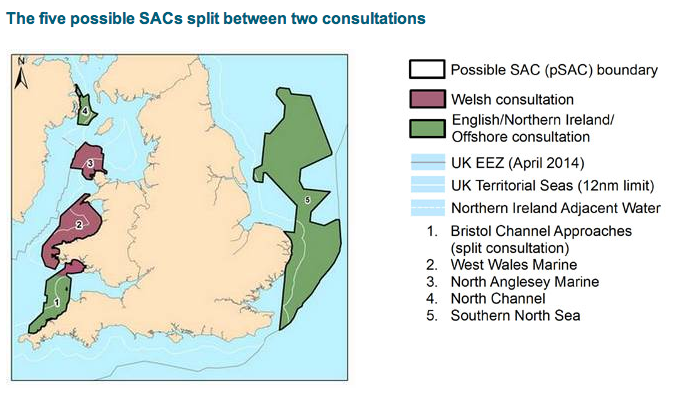Early this New Year, the statutory conservation agencies in the UK (with the exception of Scottish Natural Heritage) launched a public consultation requesting feedback on proposals for Special Areas of Conservation (SACs) for harbour porpoise, as part of the EU Habitats Directive’s requirement for a network of marine protected areas (termed Natura 2000 sites) for particular vulnerable species listed in a special annex (referred to as Annex II). On that list are the bottlenose dolphin and the harbour porpoise. The UK has three SACs for bottlenose dolphin, two in Cardigan Bay (Wales) and one in the Moray Firth (Scotland). However, in contrast to other EU maritime countries, it has not established any specifically for the harbour porpoise.
 Harbour porpoise. Photo by Pia Anderwald/ Sea Watch Foundation
Harbour porpoise. Photo by Pia Anderwald/ Sea Watch Foundation
Sea Watch has long been closely involved in the consideration of protected areas for the harbour porpoise. In 2000, it responded to DETR’s (2000) UK conservation strategy for the harbour porpoise, which argued that porpoises were so mobile and widely distributed that it was not possible to identify areas preferred by the species. The charity’s view from surveys all around the British Isles was that some sites could be identified as persistent hotspots for the species. Later that year, Sea Watch’s Director, Dr Evans, was invited by the European Commission to join a small expert workshop to discuss potential criteria for the designation of SACs for this species, given some of the challenging aspects that DETR had recognized. These subsequently formed official advice to EU member states (EC, 2007).
In 2002, the Countryside Council for Wales contracted Sea Watch to analyse further the three major data sets (Sea Watch, JNCC’s European Seabirds at Sea, and the Sea Mammal Research Unit’s 1994 SCANS survey databases) that had been collated for the NW European Cetacean Atlas (Reid et al., 2003). This analysis, undertaken in collaboration with Aberdeen University, identified four main areas and a further ten with persistent concentrations of harbour porpoise in NW European seas (Evans & Wang, 2003). The difference between the two sets of areas was basically the level of evidence available from the datasets analysed. Eight of those areas were in UK waters: Shetland Isles, coastal waters of West Scotland, southern Cardigan Bay & west Pembrokeshire; and North Devon coastal waters from the first grouping, and the outer Moray Firth eastwards to the Grampian coast; the Llyn Peninsula in North Wales; Outer Bristol Channel south to NW Cornwall; and east of the Wash in Eastern England from the second grouping. In a third category (of diminishing evidence) were two other areas in Eastern England (off the coasts of Northumberland and Yorkshire).
One of the big challenges for identifying persistent hotspots is the uneven survey coverage both in space and time, which can undermine confidence in analyses. Thus the more data one can collect to fill in those gaps, the better.
In March 2009, the European Commission held a biogeographic seminar in Galway, Ireland, at which member states bordering the Atlantic (including the North Sea) were assessed for progress in the establishment of SACs for Annex I marine habitats and Annex II marine species under the Habitats Directive. Three marine experts representing species and habitats were invited by the European Topic Centre to participate and independently evaluate the extent to which countries were fulfilling their obligations in collecting the necessary data for SAC site selection, and then implementing this. Sea Watch’s Director served as the assessor for marine mammals.
Most countries including the UK had still some way to go to fulfill their obligations, and were given a deadline to achieve these.
 A close-up of a harbour porpoise. Photo by Mick Baines/ Sea Watch Foundation
A close-up of a harbour porpoise. Photo by Mick Baines/ Sea Watch Foundation
In 2011, Sea Watch was contracted by WWF UK to make the case to the UK government for harbour porpoise SACs. This was published in 2012 (Evans & Prior, 2012). In a preliminary analysis including some new data, the following six areas were identified as potential porpoise SACs: Western Scotland & Inner Hebrides; North & West Anglesey, South-west Llyn Peninsula, Southern Cardigan Bay, Pembrokeshire Marine, and Outer Bristol Channel. A further five sites were recommended as Areas of Search, for which additional survey work was recommended: Northern Isles (Shetland & Orkney), Moray Firth (extending to east Grampian), Coastal Waters of Eastern England, Dogger Bank, and Skerries & Causeway in Northern Ireland (already recommended by DOENI).
At the end of 2013, Sea Watch was contracted by JNCC to undertake an analysis of all land-based effort-related survey data to identify whether coastal areas of harbour porpoise and bottlenose dolphin have persistent high occurrence and abundance. The international marine and freshwater environmental consultancy, DHI, was contracted to conduct an analysis of all boat and aerial-based effort-related survey data. The two reports were released in 2015 (Evans et al. 2015; Heinanen & Skov, 2015). From evidence presented in these reports, JNCC has proposed the following areas as possible SACs: In England & Northern Ireland – Bristol Channel Approaches, North Channel, and southern North Sea in England; In Wales – West Wales (west Pembrokeshire & Cardigan Bay), North Anglesey, and Welsh inshore area within the Bristol Channel Approaches. These have been announced for public consultation (consultation period is from 19 Jan – 19 Apr). JNCC also recommended four areas in Scotland (two areas in the Moray Firth – one to the southeast of the Moray Firth (off the Banff and Buchan coast, around the Southern Trench) and one over the Smith Bank (central to north eastern Moray Firth), the majority of the Minches, continuing to the south of Islay, and an area between Northern Ireland and the southwest of Scotland in the outer Solway, identified as a winter hotspot). However, Marine Scotland has not accepted JNCC’s recommendations, planning to make its own proposals before going to public consultation.
 The two public consultations for five possible SACs are lead by JNCC (green) and NRW (red). Bristol Channel approaches pSAC is split between Welsh and and JNCC consultations.
The two public consultations for five possible SACs are lead by JNCC (green) and NRW (red). Bristol Channel approaches pSAC is split between Welsh and and JNCC consultations.
Source: Harbour PorpoisePossible Special Areas of Conservation Consultation, JNCC.
Establishing Special Areas of Conservation for a species like the harbour porpoise is indeed challenging, and to make it effective, not only should the areas be of an appropriate size, but they should coincide with locations that are important to the species either as foraging or breeding (mating, birthing or nursery) areas. They do not necessarily have to limit other human activities but at least draw attention to sites of long-term importance by nature of the physical or oceanographic conditions. For discussions on the pros and cons of SACs for harbour porpoise, see Evans, 2008, 2013; Pinn, 2009; Pinn et al., 2010; and Evans & Prior, 2012.
Parties interested in responding to the public consultations are invited to go to one or both of the following websites:
JNCC: jncc.defra.gov.uk/SACconsultation
NRW: www.naturalresources.wales/mn2k
REFERENCES
DETR (2000) A UK conservation strategy for the harbour porpoise (Phocoena phocoena). Department for the Environment, Transport and the Regions; Ministry of Agriculture, Fisheries and Food; Scottish Executive Rural Affairs Department; Department of Agriculture and Rural Development (Northern Ireland); National Assembly for Wales Environment Division; Department of the Environment in Northern Ireland.
European Commission (2007) Guidelines for the establishment of the Natura 2000 network in the marine environment. Application of the Habitats and Birds Directives.
Evans P.G.H. (editor) (2008) Selection criteria for marine protected areas for cetaceans. Proceedings of the ECS/ASCOBANS/ACCOBAMS Workshop. ECS Special Publication Series no. 48: 104pp.
Evans, P.G.H. and Prior, S. (2012) Protecting the harbour porpoise in UK seas. Identifying a network of draft SACs for the harbour porpoise in the UK. A Report to WWF UK. 105pp.
Evans, P.G.H. (2013) (editor) The Challenge of Spatially Managing Cetaceans: A highly mobile animal group. Report of the Joint ECS-ASCOBANS-ACCOBAMS Workshop held at Setúbal, Portugal, 7 April 2013. ASCOBANS AC20/Doc. 4.2.1. 28pp.
Evans, P.G.H. and Wang, J. (2005) Re-examination of Distribution Data for the Harbour Porpoise around Wales and the UK with a view to site selection for this species. Countryside Council for Wales Contract Science Report No. 634. 115pp.
Evans, P.G.H., Pierce, G.J., Veneruso, G., Weir, C.R., Gibas, D., Anderwald, P., and Santos, M.B. (2015) Analysis of long-term effort-related land-based observations to identify whether coastal areas of harbour porpoise and bottlenose dolphin have persistent high occurrence and abundance. JNCC Report No 543. JNCC, Peterborough. 147pp.
Heinanen, S. and Skov, H. (2015) The identification of discrete and persistent areas of relatively high harbour porpoise density in the wider UK marine area. JNCC Report No. 544. JNCC, Peterborough. 108pp.
Pinn, E. (2009) Threshold for Designation of Special Areas of Conservation for Harbour Porpoise and other highly mobile, wide ranging marine species. Annex 1 to JNCC Committee paper P10Sep08, amended 13 February 2009. JNCC, Aberdeen. 20pp.
Pinn, E., Tasker, M., Mendes, S., and Goold, J. (2010) Maintaining Favourable Conservation Status of Harbour Porpoise in UK waters. Joint Nature Conservation Committee, Aberdeen. 17pp.
Reid, J.B., Evans, P.G.H. and Northridge, S.P. (2003) Atlas of Cetacean Distribution in North-west European Waters. Joint Nature Conservation Committee, Peterborough. 76pp.
























